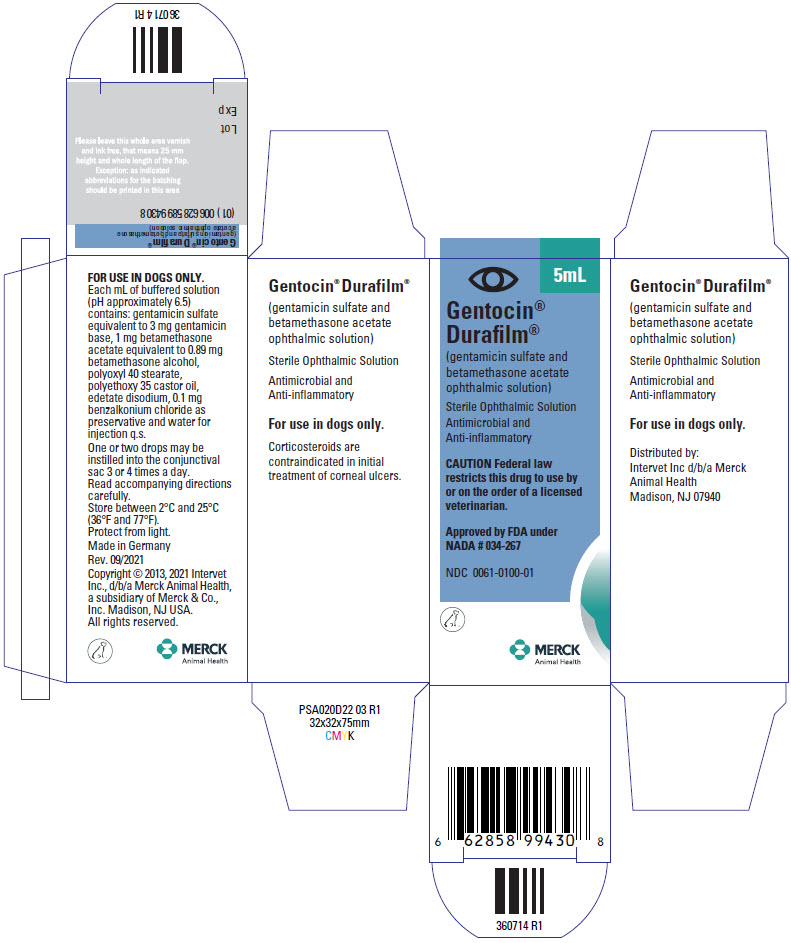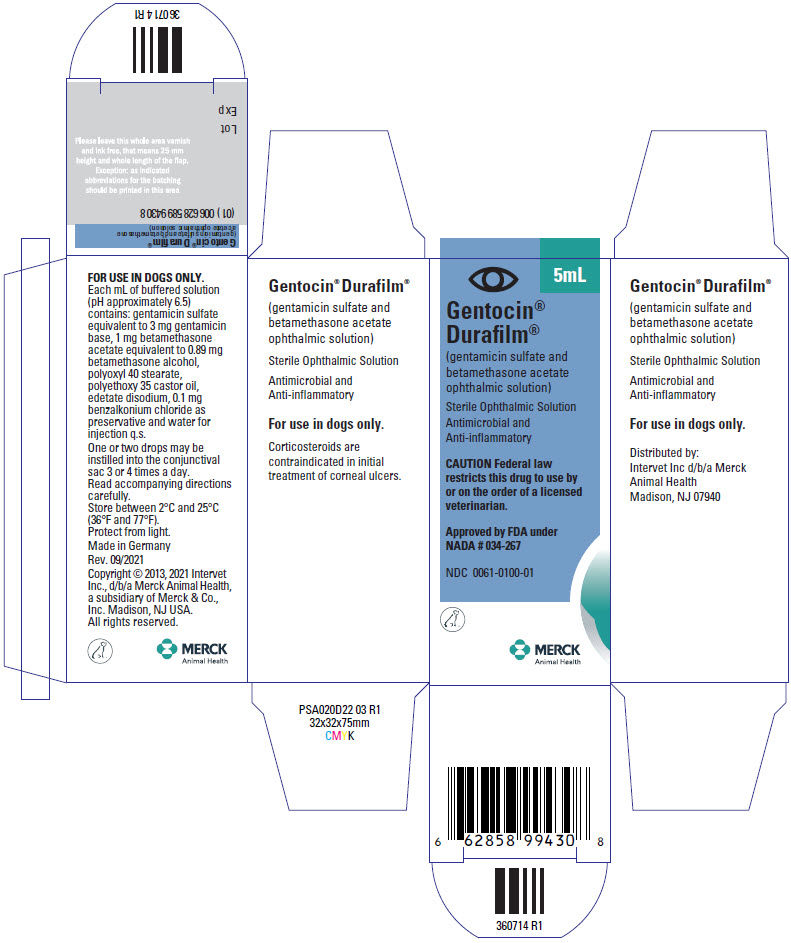Label: GENTOCIN DURAFILM- gentamicin sulfate and betamethasone acetate solution
- NDC Code(s): 0061-0100-01
- Packager: Merck Sharp & Dohme Corp.
- Category: PRESCRIPTION ANIMAL DRUG LABEL
- DEA Schedule: None
- Marketing Status: New Animal Drug Application
Drug Label Information
Updated November 15, 2024
If you are a consumer or patient please visit this version.
- Download DRUG LABEL INFO: PDF XML
- Official Label (Printer Friendly)
- SPL UNCLASSIFIED SECTION
-
DESCRIPTION
DESCRIPTION GENTOCIN DURAFILM Ophthalmic Solution is a sterile preparation for topical application. Each mL of buffered solution (pH approximately 6.5) contains gentamicin sulfate equivalent to 3 mg gentamicin base, 1 mg betamethasone acetate equivalent to 0.89 mg betamethasone alcohol, polyoxyl 40 stearate, polyethoxy 35 castor oil, edetate disodium, 0.1 mg benzalkonium chloride as preservative and water for injection q.s.
Gentamicin is a bactericidal antibiotic of the aminoglycoside group derived from Micromonospora purpurea of the Actinomyces group. It is a powder, white to buff in color, basic in nature, readily soluble in water and highly stable in solution.
Betamethasone, a synthetic derivative of prednisolone, is 9-alpha-fluoro-16-beta-methyl-prednisolone.
-
VETERINARY INDICATIONS
INDICATIONS GENTOCIN DURAFILM Ophthalmic Solution is indicated for the treatment of external eye infections and inflammation in dogs.
Clinical reports indicate it is useful for the management of some cases of pigmentary keratitis and pannus. Temporary remission of some of the pathological lesions of the aforementioned conditions have been noted following therapy with GENTOCIN DURAFILM Ophthalmic Solution.
-
DOSAGE & ADMINISTRATION
DOSAGE AND ADMINISTRATION The topical application of GENTOCIN DURAFILM Ophthalmic Solution should, in each instance, be administered to meet the specific needs of the individual case. One or two drops of the solution may be instilled into the conjunctival sac three or four times a day. Thereafter, the frequency of the dosage may be reduced but care should be taken not to discontinue therapy prematurely. In chronic conditions, withdrawal of treatment should be carried out by gradually decreasing the frequency of application.
- CONTRAINDICATIONS
-
WARNINGS
WARNINGS Not for human use. Keep this and all drugs out of the reach of children. Clinical and experimental data have demonstrated that corticosteroids administered orally or parenterally to animals may induce the first stage of parturition when administered during the last trimester of pregnancy and may precipitate premature parturition followed by dystocia, fetal death, retained placenta, and metritis.
Additionally, corticosteroids administered to dogs, rabbits, and rodents during pregnancy have produced cleft palate. Other congenital anomalies including deformed forelegs, phocomelia, and anasarca have been reported in offspring of dogs which received corticosteroids during pregnancy.
-
PRECAUTIONS
PRECAUTIONS The antibiotic sensitivity of the infective organism in bacterial conjunctivitis should be determined prior to the use of this preparation. The preparation is contraindicated in the case of nonsusceptible microorganisms. In deep-seated infections or when systemic infection threatens, specific systemic antibiotic or sulfonamide therapy should be employed.
Extended use of topical corticosteroids may cause increased intraocular pressure in susceptible patients. In prolonged therapy, it is advisable to measure intraocular pressure. In human medicine, in diseases that cause thinning of the cornea, perforation has been known to have occurred with the use of topical steroids.
Use of corticosteroids, depending on dose, duration, and specific steroid, may result in inhibition of endogenous steroid production following drug withdrawal. In patients presently receiving or recently withdrawn from systemic corticosteroid treatments, therapy with a rapidly acting corticosteroid should be considered in especially stressful situations.
-
ADVERSE REACTIONS
ADVERSE REACTIONS SAP and SGPT (ALT) enzyme elevations, polydipsia, and polyuria have occurred following parenteral or systemic use of synthetic corticosteroids in dogs. Vomiting and diarrhea (occasionally bloody) have been observed in dogs.
Cushing's syndrome in dogs has been reported in association with prolonged or repeated steroid therapy.
A transient stinging sensation, usually expressed as some form of resentment by the animal, following topical application of the drug, has been noted in a small number of cases. Usually this does not require discontinuance of therapy.
To report an adverse reaction, product-related problem, or human exposure, please call Merck Animal Health Technical Services at 1-800-224-5318.
To obtain a copy of the Material Safety Data Sheet (MSDS), call 1-800-770-8878.
For additional information about adverse drug experience reporting for animal drugs, contact FDA at 1-888-FDA-VETS or http://www.fda.gov/reportanimalae
-
CLINICAL PHARMACOLOGY
CLINICAL PHARMACOLOGY GENTOCIN DURAFILM Ophthalmic Solution incorporates polyoxyl 40 stearate and polyethoxy 35 castor oil which provide a colloidal dispersion of active ingredients. This aqueous colloidal solution offers specific advantages in treating eye conditions. DURAFILM covers the conjunctiva with a thin, clear, quickly spreading film which carries therapeutic components to accessible structures and maintains prolonged contact.
GENTOCIN DURAFILM Ophthalmic Solution provides the antibacterial properties of gentamicin sulfate plus the anti-inflammatory action of betamethasone acetate.
Gentamicin sulfate, a wide-spectrum antibiotic, is a highly effective topical treatment in primary and secondary bacterial infections of the eye and surrounding tissues. Gentamicin is bactericidal in vitro against a wide variety of gram-positive and gram-negative bacteria. Concentrations of gentamicin sulfate required to inhibit growth of gram positive and gram-negative clinical and laboratory strains of bacteria tested were less than those of neomycin in most instances.1. Gentamicin is active against most gram-negative bacteria including Pseudomonas aeruginosa, indole positive and negative Proteus species, Escherichia coli, Kiebsiella pneumoniae, Aerobacter aerogenes, and Neisseria. Gentamicin is also active against strains of gram-positive bacteria including Staphylococcus species and Group A Beta-Hemolytic Streptococci.
Betamethasone produces hormonal and metabolic effects common to all adrenocortical steroids, and in low dosage affords anti-inflammatory, anti-allergic, and anti-rheumatic effects. Studies in man show the glucocorticoid activity of betamethasone to be 10 to 15 times greater than prednisone. Betamethasone helps control excessive tissue reaction to infections, allergens, and trauma. The corticoids control the inflammatory and exudate phases of eye conditions, particularly those affecting the anterior chamber and external structure of the eye. However, they do not curtail the growth of the causative organisms. Betamethasone therapy may reduce the damaging sequelae in certain eye diseases and injuries as well as scarring and vascularization, and appears to alter the usual tissue response to injury. In initial acute phases of inflammation, local application of betamethasone provides prompt, symptomatic relief, accomplishing temporary control of the exudative phase, whether of bacterial, allergic, or traumatic origin.
Betamethasone also inhibits fibroblast formation during tissue repair.
-
SPL UNCLASSIFIED SECTION
ANIMAL SAFETY In a target animal safety study, GENTOCIN DURAFILM Ophthalmic Solution was administered for 14 consecutive days to healthy Beagle dogs at a dose of 2 drops/eye 4 times daily (1× maximum daily dose; 8 dogs), 4 drops/eye 4 times daily (2× maximum daily dose; 8 dogs), and 6 drops/eye (3× maximum daily dose; 8 dogs). Eight dogs received 6 drops of sterile saline/eye 4 times daily (Control 0×). A mild serous ocular discharge was observed in GENTOCIN DURAFILM treated dogs in a dose-related manner; which resolved within a few hours of dosing. Mild bilateral scleral redness was seen in the 2× and 3× groups between Days 4-8 which spontaneously resolved. Polyuria was evident in 1 of 8 dogs in the 3× group on Day 2, and was evident in a dose proportional manner in all three treatment groups after 14 days of dosing- 1× group (3 of 8 dogs), 2× group (7 of 8 dogs) and 3× group (8 of 8 dogs). In dogs from each GENTOCIN DURAFILM treated group, changes in hematological parameters included neutrophilia, lymphopenia, eosinopenia and decreased reticulocytes, and changes in blood chemistries included increased ALT, SAP, GGT, triglycerides, albumin, globulin and total protein levels and decreased CK levels. Urine specific gravity was decreased in each GENTOCIN DURAFILM treated group. Dogs in the GENTOCIN DURAFILM treated groups also had increased food consumption compared to dogs in the control group.
- HOW SUPPLIED
- REFERENCES
- SPL UNCLASSIFIED SECTION
-
PRINCIPAL DISPLAY PANEL - 5 mL Bottle Carton
5mL
Gentocin®
Durafilm®(gentamicin sulfate and
betamethasone acetate
ophthalmic solution)Sterile Ophthalmic Solution
Antimicrobial and
Anti-inflammatoryCAUTION Federal law
restricts this drug to use by
or on the order of a licensed
veterinarian.Approved by FDA under
NADA # 034-267NDC 0061-0100-01
MERCK
Animal Health
-
INGREDIENTS AND APPEARANCE
GENTOCIN DURAFILM
gentamicin sulfate and betamethasone acetate solutionProduct Information Product Type PRESCRIPTION ANIMAL DRUG Item Code (Source) NDC:0061-0100 Route of Administration OPHTHALMIC Active Ingredient/Active Moiety Ingredient Name Basis of Strength Strength GENTAMICIN SULFATE (UNII: 8X7386QRLV) (GENTAMICIN - UNII:T6Z9V48IKG) GENTAMICIN 3 mg in 1 mL BETAMETHASONE ACETATE (UNII: TI05AO53L7) (BETAMETHASONE - UNII:9842X06Q6M) BETAMETHASONE ACETATE 0.89 mg in 1 mL Packaging # Item Code Package Description Marketing Start Date Marketing End Date 1 NDC:0061-0100-01 1 in 1 CARTON 1 5 mL in 1 BOTTLE, DROPPER Marketing Information Marketing Category Application Number or Monograph Citation Marketing Start Date Marketing End Date NADA NADA034267 11/30/2014 Labeler - Merck Sharp & Dohme Corp. (001317601)

